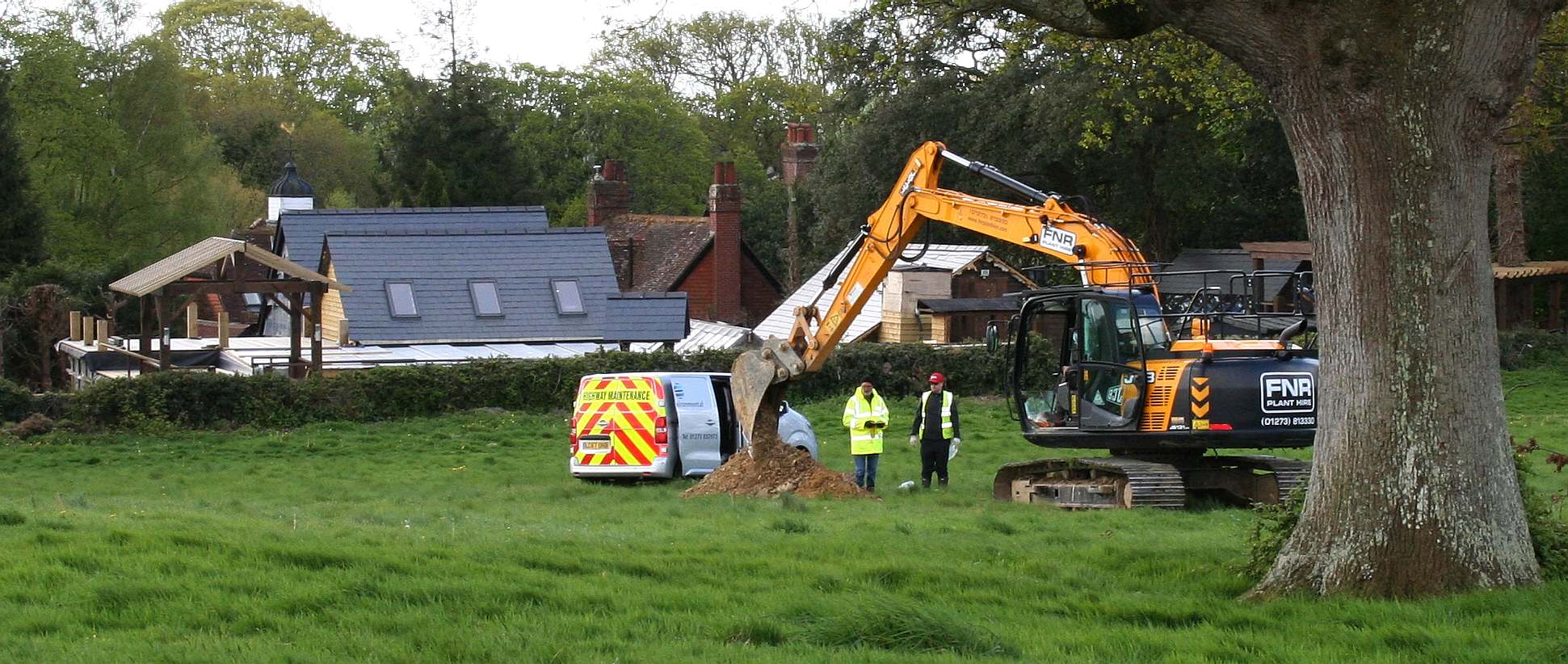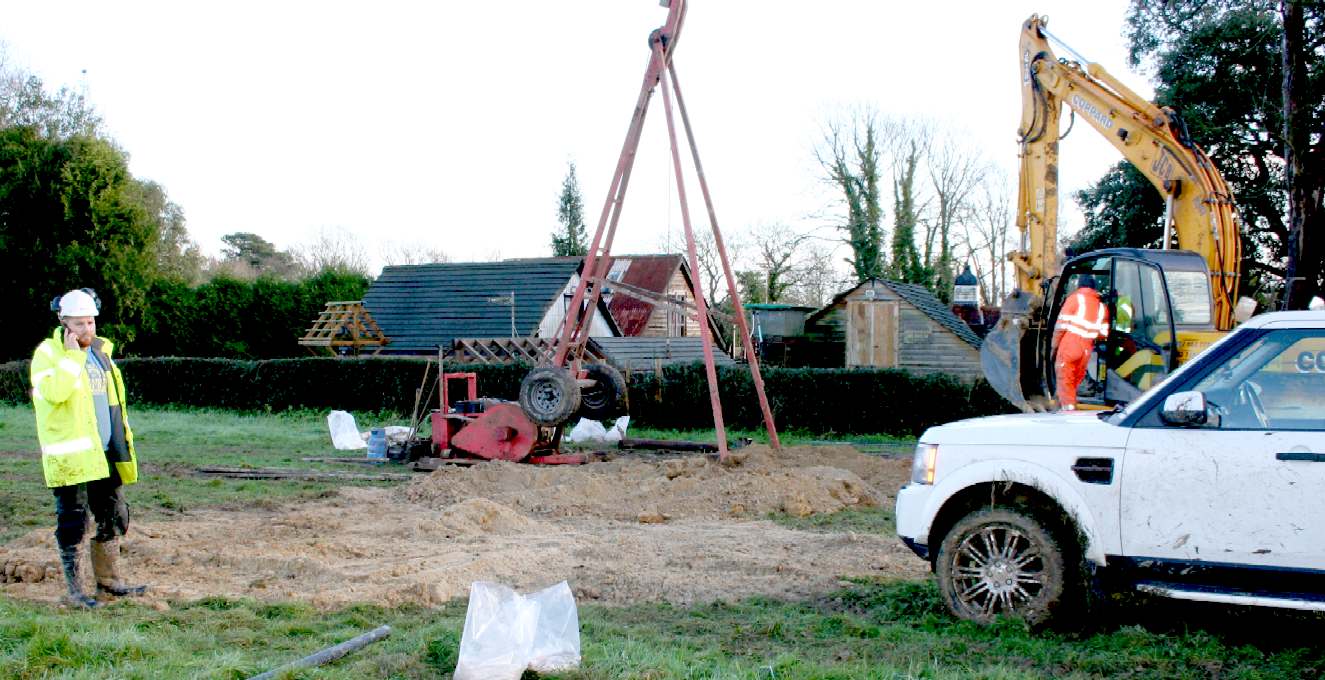|

WATER
RIGHTS - Clarion Housing Group and Thakeham
Homes are in danger of spoiling an ancient well that supplies water
to many concerns in this vicinity. In the picture you can see a hired
digger scooping out trenches to test drainage by pouring in water and
measuring the rate of absorption by the soil. It seems to us that if you
build houses on the ground that feeds the ancient well, that
contamination from garden treatments such as Roundup and engine oils,
etc., will find its way into this well leading to claims against the
owners of the houses who would have been sold a pup, and/or against the
Council for approving the proposal, by way of a negligence claim, and/or
against the vendors or developers. Any way you look at it the developers
and Council concerned should take steps to ensure that no development
takes place until the proper tests and evaluations have been completed,
and after that stage, to ensure that any houses built in this location
will not be on a path that includes the water
table that feeds the ancient well.
Any
failure to conduct the proper tests and house situation, along with safe
sewage disposal, may tempt the Secretary
of State to call in the application. We imagine that all of those
with a financial interest in this piece of greenbelt will want to
resolve issues before it starts to get complicated.
9.
MEETING THE CHALLENGE OF CLIMATE CHANGE, FLOODING AND COASTAL CHANGE
93. Planning plays a key role in helping shape places to secure radical reductions
in greenhouse gas emissions, minimising vulnerability and providing resilience
to the impacts of climate change, and supporting the delivery of renewable
and low carbon energy and associated infrastructure. This is central to the
economic, social and environmental dimensions of sustainable development.
94. Local planning authorities should adopt proactive strategies to mitigate and
adapt to climate change,16 taking full account of flood risk, coastal change
and water supply and demand considerations.
95. To support the move to a low carbon future, local planning authorities
should:
●● plan for new development in locations and ways which reduce
greenhouse
gas emissions;
●● actively support energy efficiency improvements to existing buildings; and
●● when setting any local requirement for a building’s sustainability, do so in
a way consistent with the Government’s zero carbon buildings policy and
adopt nationally described standards.
96. In determining planning applications, local planning authorities should expect
new development to:
●● comply with adopted Local Plan policies on local requirements for
decentralised energy supply unless it can be demonstrated by the
applicant, having regard to the type of development involved and its
design, that this is not feasible or viable; and
●● take account of landform, layout, building orientation, massing and
landscaping to minimise energy consumption.
97. To help increase the use and supply of renewable and low carbon energy,
local planning authorities should recognise the responsibility on all
communities to contribute to energy generation from renewable or low
carbon sources. They should:
●● have a positive strategy to promote energy from renewable and low
carbon sources;
●● design their policies to maximise renewable and low carbon energy
development while ensuring that adverse impacts are addressed
satisfactorily, including cumulative landscape and visual impacts;
●● consider identifying suitable areas for renewable and low carbon energy
sources, and supporting infrastructure, where this would help secure the
development of such sources;
●● support community-led initiatives for renewable and low carbon energy,
including developments outside such areas being taken forward through
neighbourhood planning; and
●● identify opportunities where development can draw its energy supply from
decentralised, renewable or low carbon energy supply systems and for
co-locating potential heat customers and suppliers.
98. When determining planning applications, local planning authorities should:
●● not require applicants for energy development to demonstrate the overall
need for renewable or low carbon energy and also recognise that even
small-scale projects provide a valuable contribution to cutting greenhouse
gas emissions; and
●● approve the application if its impacts are (or can be made) acceptable.
Once suitable areas for renewable and low carbon energy have been
identified in plans, local planning authorities should also expect
subsequent applications for commercial scale projects outside these areas
to demonstrate that the proposed location meets the criteria used in
identifying suitable areas.
99. Local Plans should take account of climate change over the longer term,
including factors such as flood risk, coastal change, water supply and
changes to biodiversity and landscape. New development should be planned
to avoid increased vulnerability to the range of impacts arising from climate
change. When new development is brought forward in areas which are
vulnerable, care should be taken to ensure that risks can be managed
through suitable adaptation measures, including through the planning
of green infrastructure.
100. Inappropriate development in areas at risk of flooding should be avoided by
directing development away from areas at highest risk, but where
development is necessary, making it safe without increasing flood risk
elsewhere. Local Plans should be supported by Strategic Flood Risk
Assessment and develop policies to manage flood risk from all sources,
taking account of advice from the Environment Agency and other relevant
flood risk management bodies, such as lead local flood authorities and
internal drainage boards. Local Plans should apply a sequential, risk-based
approach to the location of development to avoid where possible flood risk
to people and property and manage any residual risk, taking account of the
impacts of climate change, by:
●● applying the Sequential Test;
●● if necessary, applying the Exception Test;
●● safeguarding land from development that is required for current and
future flood management;
●● using opportunities offered by new development to reduce the causes and
impacts of flooding; and
●● where climate change is expected to increase flood risk so that some
existing development may not be sustainable in the long-term, seeking
opportunities to facilitate the relocation of development, including
housing, to more sustainable locations.
101. The aim of the Sequential Test is to steer new development to areas with the
lowest probability of flooding. Development should not be allocated or
permitted if there are reasonably available sites appropriate for the proposed
development in areas with a lower probability of flooding. The Strategic
Flood Risk Assessment will provide the basis for applying this test. A
sequential approach should be used in areas known to be at risk from any
form of flooding.
102. If, following application of the Sequential Test, it is not possible, consistent
with wider sustainability objectives, for the development to be located in
zones with a lower probability of flooding, the Exception Test can be applied
if appropriate. For the Exception Test to be passed:
●● it must be demonstrated that the development provides wider
sustainability benefits to the community that outweigh flood risk,
informed by a Strategic Flood Risk Assessment where one has been
prepared; and
●● a site-specific flood risk assessment must demonstrate that the
development will be safe for its lifetime taking account of the vulnerability
of its users, without increasing flood risk elsewhere, and, where possible,
will reduce flood risk overall.
Both elements of the test will have to be passed for development to be
allocated or permitted.
103. When determining planning applications, local planning authorities should
ensure flood risk is not increased elsewhere and only consider development
appropriate in areas at risk of flooding where, informed by a site-specific
flood risk assessment following the Sequential Test, and if required the
Exception Test, it can be demonstrated that:
●● within the site, the most vulnerable development is located in areas of
lowest flood risk unless there are overriding reasons to prefer a different
location; and
●● development is appropriately flood resilient and resistant, including safe
access and escape routes where required, and that any residual risk can be
safely managed, including by emergency planning; and it gives priority to
the use of sustainable drainage systems.
104. For individual developments on sites allocated in development plans through
the Sequential Test, applicants need not apply the Sequential Test.
Applications for minor development and changes of use should not be
subject to the Sequential or Exception Tests but should still meet the
requirements for site-specific flood risk assessments.
105. In coastal areas, local planning authorities should take account of the UK
Marine Policy Statement and marine plans and apply Integrated Coastal Zone
Management across local authority and land/sea boundaries, ensuring
integration of the terrestrial and marine planning regimes.
106. Local planning authorities should reduce risk from coastal change by avoiding
inappropriate development in vulnerable areas or adding to the impacts of
physical changes to the coast. They should identify as a Coastal Change
Management Area any area likely to be affected by physical changes to the
coast, and:
●● be clear as to what development will be appropriate in such areas and in
what circumstances; and
●● make provision for development and infrastructure that needs to be
relocated away from Coastal Change Management Areas.
107. When assessing applications, authorities should consider development in a
Coastal Change Management Area appropriate where it is demonstrated
that:
●● it will be safe over its planned lifetime and will not have an unacceptable
impact on coastal change;
●● the character of the coast including designations is not compromised;
●● the development provides wider sustainability benefits; and
●● the development does not hinder the creation and maintenance of a
continuous signed and managed route around the coast.
108. Local planning authorities should also ensure appropriate development in a
Coastal Change Management Area is not impacted by coastal change by
limiting the planned life-time of the proposed development through
temporary permission and restoration conditions where necessary to reduce
the risk to people and the development.
CONTACTS
Department for Communities and Local Government
Eland House
Bressenden Place
London,
SW1E 5DU
United
Kingdom
Telephone: 030 3444 0000

HINKLEY,
CALIFORNIA - GROUND WATER CONTAMINATION - The
town of Hinkley, California,
located in the Mojave Desert, (about 121 miles driving distance
north-northeast of Los Angeles) had its groundwater contaminated with
hexavalent chromium starting in 1952, resulting in a legal case
against Pacific Gas & Electric (PG&E) and a multimillion-dollar
settlement in 1996. The legal case was dramatized in the film Erin
Brockovich, released in 2000.
Residents of Hinkley filed a class action against PG&E,
encaptioned Anderson, et al. v. Pacific Gas and Electric (Superior Ct.
for County of San Bernardino, Barstow Division, file BCV 00300.
In 1993, Erin Brockovich, a legal clerk to lawyer Edward L. Masry,
investigated the apparent elevated cluster of illnesses in the
community linked to hexavalent chromium. The efforts of Brockovich and
Masry, and the plight of the people of Hinkley, became widely known
when the film Erin Brockovich was released in 2000.


After
many arguments, the case was referred to arbitration with maximum
damages of $400 million. After the arbitration for the first 40 people
resulted in roughly $110 million,
PG&E reassessed its position and decided to end arbitration and
settle the entire case. The case was settled in 1996 for $333 million,
the largest settlement ever paid in a direct-action lawsuit in U.S.
history.
In 2006, PG&E agreed to pay $295 million to settle cases involving
another 1,100 people statewide for hexavalent chromium-related claims.
In 2008, PG&E
settled the last of the cases involved with the Hinkley claims for $20
million.
LEAD
CASE: In the case of Wealden
District Council and planning application WD/2015/0090/MAO,
originally filed by Tim
Watson in 2014, then re-filed by Gleeson
Developments in 2015, and taken over by Clarion
Group and Thakeham
Group, there appear to be multiple errors in applying these
policies to greenbelt, including failing to protect open spaces and
the historic built environment, and not promoting sustainable
transport.
The
Horse
Sanctuary Trust are following this case with much interest. We
consider that the paper trail will eventually make interesting
reading, leading us to who is making the decisions and the money
........

GREENBELT
- Digging up Greenfield sites for quick
profits from windfall planning consents is ruining the heritage of
the nation. Once it is gone, it is gone. Britain is short of genuinely
affordable housing that developers are loath to provide where all they
want is the money. It may be that Clarion Housing and Thakeham intend
building affordable units on this site. They should also bear in mind
the requirement for sustainable development in United
Nations terms. Copyright photograph © April 26 2018, Herstmonceux
Museum Limited. All rights reserved. You may not copy this picture
except for educational
use.
|




